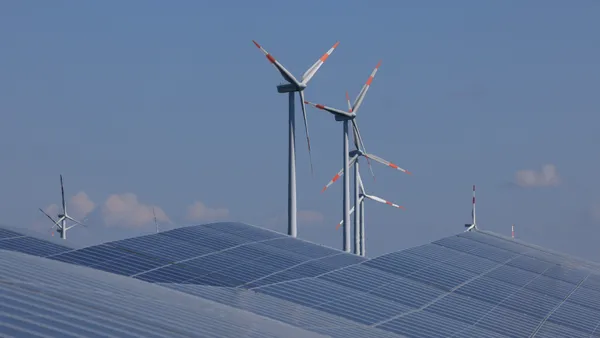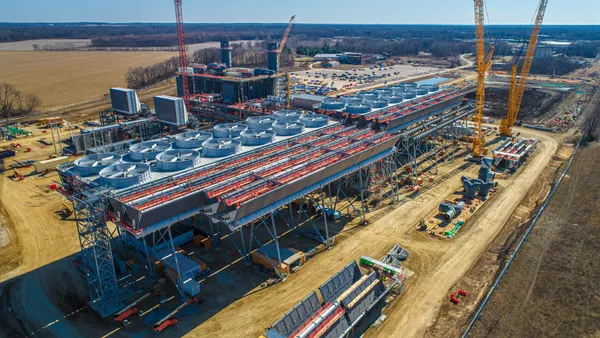Dive Brief:
- A final decision on a high-profile solar trade case is coming "pretty soon," President Donald Trump told Reuters on Wednesday. However he declined to say how harsh the potential trade duties would be.
- Trump noted the consequences of low-priced imports on domestic manufacturers in the interview: "You know, they dump 'em — government-subsidized, lots of things happening — they dump the panels, then everybody goes out of business.". In a joint statement, the petitioners Suniva and SolarWorld applauded Trump's remarks: "Now the President can save and rebuild this great American industry and create thousands of jobs by immediately imposing 50 percent tariffs - the strongest tariffs possible."
- Abigail Hopper, the president of the Solar Energy Industries Association, which has vehemently opposed any trade duties, sent a last minute letter imploring Trump not to impose strict duties on imported chrystalline silicon photovoltaic cells and modules. "Ironically, the very jobs we all want to grow, American manufacturing jobs, will retract as the number of projects are scaled back significantly," Hopper wrote.
Dive Insight:
Uncertainty over Trump's decision in the solar trade case underpins the solar industry right now. Both sides are engaged in last minute lobbying efforts to sway Trump. A final report from the U.S. Office of the Trade Representative is reportedly in Trump's hands, fueling more speculation as to the contents.
Industry sources told E&E News that the report would exclude a proposed licensing fee from SEIA over questions of its legality. And another industry source told Greentech Media that the administration isn't "going to embrace the more restrictive recommendations the [U.S. International Trade Commission] made." The different media reports merely intensifies the speculation.
It's clear no one knows how Trump will decide, but based on his past and latest remarks, the sector is bracing for some kind of trade duty. The case has frequently been compared to the last Section 201 case in 2001, which sought global duties for imported steel. Unlike steel, solar can easily be swapped for other resources, such as gas and wind, Paul Nathanson, a principal at Bracewell, told Utility Dive last year. Eleventh-hour lobbying also can change the game as well, he added.
In early April, a pair of U.S.-based manufacturers sought trade relief under a rarely-used safeguard measure under the Trade Act of 1974. Section 201, as it's commonly known, essentially places duties on all countries, though separate findings are required for countries under certain trade agreements. Unlike other trade protection measures, the President has sole control of the final decision. Given Trump's public disdain for solar, the potential for punitive measures thrust uncertainty into the sector.
The ITC found cause for injury and recommended three remedies, composed of a variety of quotas, tariffs and SEIA's licensing fees. None were as severe as the petitioners' proposals.
Sunvia/SolarWorld Americas
Tariffs:
- $0.25/watt for cells that would drop to $0.235/watt in four years
- $0.32/watt for modules that would drop to $0.29 in four years
Suniva
Floor price:
- $0.74/watt that would decline to $0.64/watt in four years
SolarWorld Americas
Quotas:
- 0.22 GW for cells that would increase to 0.37 GW in four years
- 5.7 GW for modules that would increase to 9 GW in four years
Indeed, a GTM Research report suggests the solar industry could weather the ITC's proposals.
Even so, the majority of the domestic solar industry and Trump's conservative allies condemned the petitioners' request. SEIA cited potential job losses numbering in the tens of thousands — currently 260,000 jobs compose the industry, most of them in installation. According to SEIA, manufacturing jobs number only 38,000 or 14%.
But SolarWorld and Suniva, both in bankruptcy proceedings, note that hefty imports from Chinese manufacturers have hurt the domestic manufacturing space — something ITC agreed with in a supplemental report sent to the USTR. Both companies told Utility Dive that without severe duties, they could not compete.
However, experts noted that any decision from Trump could be challenged at the World Trade Organization. Clark Packard, a trade analyst with free market think tank R Street Institute, told Bloomberg countries could retaliate through other trade duties targeting key states held by prominent GOP Congressmen.
A representative from the Republic of China gave credence to the idea of eventual challenge during one of the marathon hearings at the ITC last year. But Greentech Media noted that the ITC's supplemental report for the USTR could help the Trump administration prep for a potential WTO challenge.
Trump has until Jan. 26 to make a final decision; however, under Section 201, he could delay that decision for an additional 90 days should he pursue a negotiated settlement that could entail broader discussions on previous counter-veiling and anti-dumping duties imposed a few years ago, according to Greentech Media. If that's the case, this could address an alternative proposal from Craig Cornelius, the senior vice president of NRG Renewables.
Instead of remedies, the Trump administration could ask China to terminate its duties on U.S.-manufactured polysilicon that the country imposed in 2013 in response to trade duties on solar equipment imports.
In turn, U.S. would lift the anti-dumping and counter-veiling duties they imposed on China in 2012 — also at the behest of SolarWorld. Roughly $1.5 billion in revenue collected from those duties would then be redistributed to domestic CSVP manufacturers, and also used to repay companies who already paid those tariffs.














